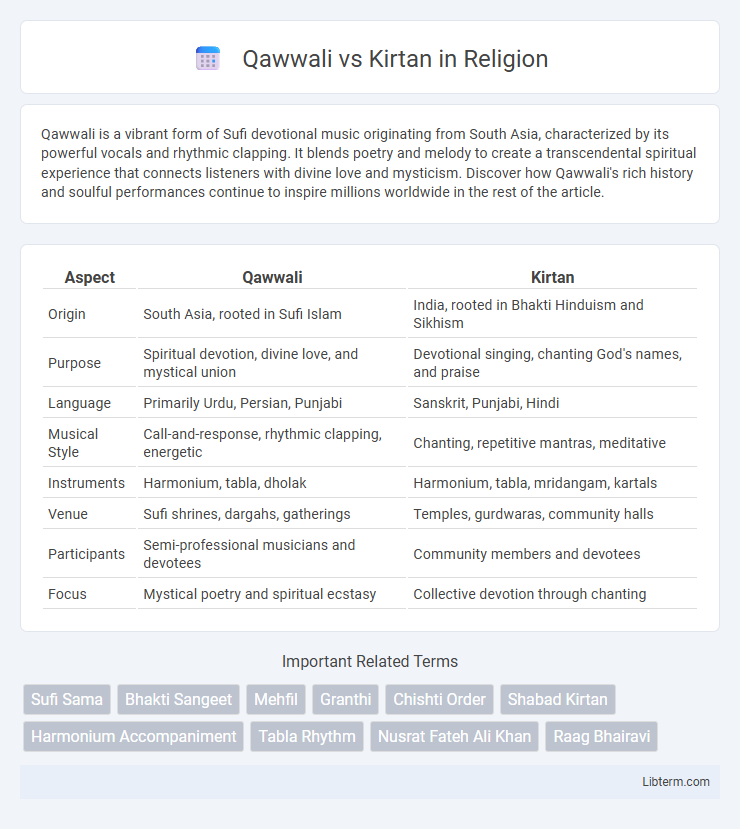Qawwali is a vibrant form of Sufi devotional music originating from South Asia, characterized by its powerful vocals and rhythmic clapping. It blends poetry and melody to create a transcendental spiritual experience that connects listeners with divine love and mysticism. Discover how Qawwali's rich history and soulful performances continue to inspire millions worldwide in the rest of the article.
Table of Comparison
| Aspect | Qawwali | Kirtan |
|---|---|---|
| Origin | South Asia, rooted in Sufi Islam | India, rooted in Bhakti Hinduism and Sikhism |
| Purpose | Spiritual devotion, divine love, and mystical union | Devotional singing, chanting God's names, and praise |
| Language | Primarily Urdu, Persian, Punjabi | Sanskrit, Punjabi, Hindi |
| Musical Style | Call-and-response, rhythmic clapping, energetic | Chanting, repetitive mantras, meditative |
| Instruments | Harmonium, tabla, dholak | Harmonium, tabla, mridangam, kartals |
| Venue | Sufi shrines, dargahs, gatherings | Temples, gurdwaras, community halls |
| Participants | Semi-professional musicians and devotees | Community members and devotees |
| Focus | Mystical poetry and spiritual ecstasy | Collective devotion through chanting |
Introduction to Qawwali and Kirtan
Qawwali, a devotional music form rooted in Sufi Islam, uses powerful vocals, harmonium, and tabla to evoke spiritual ecstasy and convey mystical poetry often in Urdu or Punjabi. Kirtan, central to Sikh and Hindu traditions, involves call-and-response chanting of sacred mantras and hymns, accompanied by instruments like the harmonium, tabla, and kartals to facilitate communal meditation and devotional singing. Both serve as profound spiritual practices, yet Qawwali emphasizes Sufi mysticism while Kirtan focuses on Bhakti devotion and collective worship.
Historical Origins and Evolution
Qawwali, originating in the 13th-century Indian subcontinent, evolved from Sufi devotional music aimed at expressing spiritual themes through powerful vocal performances and rhythmic clapping. Kirtan traces its roots to ancient Vedic traditions, flourishing within Sikhism and Bhakti movements as a call-and-response singing form focused on sacred Hindu and Sikh scriptures. Both genres have dynamically adapted over centuries, with Qawwali incorporating Persian and Arabic influences, while Kirtan expanded regionally, integrating diverse linguistic styles.
Core Philosophies and Spiritual Messages
Qawwali, rooted in Sufi Islam, emphasizes divine love and union with God through ecstatic musical poetry that celebrates devotion and spiritual longing. Kirtan, central to Sikhism and Hinduism, focuses on collective chanting of God's names to cultivate inner peace, humility, and devotion as a path to spiritual awakening. Both traditions use music as a medium to transcend the physical realm, yet Qawwali highlights personal mystical experience while Kirtan encourages communal harmony and remembrance of the divine.
Musical Structure and Performance Styles
Qawwali features a dynamic call-and-response structure with repetitive chorus and improvisational passages, driven by harmonium and tabla, often performed by a lead singer with a group of chorus vocalists. Kirtan emphasizes collective singing of devotional mantras or hymns, characterized by simple melodic patterns and rhythmic clapping or percussion instruments like the mridangam or kartal. Both forms rely on communal participation, but Qawwali's elaborate vocal embellishments contrast with Kirtan's straightforward, meditative chanting style.
Language and Lyrical Themes
Qawwali predominantly uses Urdu, Punjabi, and Persian languages, embedding Sufi mysticism and love for the Divine in its lyrical themes, emphasizing devotion, spiritual longing, and union with God. Kirtan is primarily performed in Sanskrit, Hindi, and other regional Indian languages, focusing on bhakti (devotional worship), praising Hindu deities, and fostering communal spiritual experience. Both forms use repetitive, poetic melodies to enhance devotion but differ in linguistic heritage and the nature of their religious expression.
Key Instruments Used
Qawwali primarily features the harmonium, tabla, and dholak, creating rhythmic and melodic layers that support powerful vocal improvisations. Kirtan relies on instruments such as the harmonium, mridangam, and kartals, emphasizing repetitive melodies and call-and-response chanting. Both musical forms utilize the harmonium, but Qawwali integrates more percussive elements like the tabla, while Kirtan emphasizes traditional Indian drums and hand cymbals.
Major Exponents and Traditions
Qawwali, rooted in Sufi Islamic traditions, features major exponents like Nusrat Fateh Ali Khan, known for his powerful vocal delivery and spiritual themes. Kirtan, integral to Hindu and Sikh devotional practices, highlights figures such as Bhai Harjinder Singh and Bhakti saints, emphasizing communal singing and mantra repetition. Both traditions maintain rich musical legacies, with Qawwali's rhythmic clapping and harmonium complemented by Kirtan's use of instruments like the tabla and harmonium.
Rituals and Audience Participation
Qawwali and Kirtan rituals center around devotional music but differ in style and audience engagement; Qawwali, rooted in Sufi Islam, features passionate vocal performances and rhythmic clapping that encourage trance-like states, while Kirtan, linked to Sikh and Hindu traditions, emphasizes call-and-response chanting with communal singing and instrumental accompaniment. Audience participation in Qawwali involves active clapping, emotional responsiveness, and collective spiritual expression, whereas Kirtan participants join in repetitive mantras and singing, fostering meditative unity and devotion. Both rituals rely heavily on communal involvement to deepen spiritual connection and transcendence through music.
Cultural Impact and Global Reach
Qawwali and Kirtan both hold significant cultural impact as traditional devotional music forms, with Qawwali rooted in Sufi Islam and Kirtan in Hindu and Sikh practices, deeply shaping their respective religious communities and rituals. Qawwali's energetic performances have gained global recognition through artists like Nusrat Fateh Ali Khan, influencing world music and fusion genres beyond South Asia. Meanwhile, Kirtan's call-and-response chanting has attracted a diverse international following through yoga and meditation movements, expanding its global reach into wellness and spiritual practices worldwide.
Comparative Analysis: Similarities and Differences
Qawwali and Kirtan are devotional music traditions that emphasize the spiritual connection through repetitive chanting and call-and-response patterns, fostering communal participation. While Qawwali originates from Sufi Islam, featuring Persian and Urdu lyrics with rhythmic harmoniums and tablas, Kirtan stems from Hindu Bhakti traditions, using Sanskrit or regional languages accompanied by cymbals and mridangam drums. Both styles aim to induce trance-like states for spiritual upliftment, but Qawwali often integrates poetic expressions of divine love and longing, whereas Kirtan emphasizes collective singing of divine names and scriptures.
Qawwali Infographic

 libterm.com
libterm.com